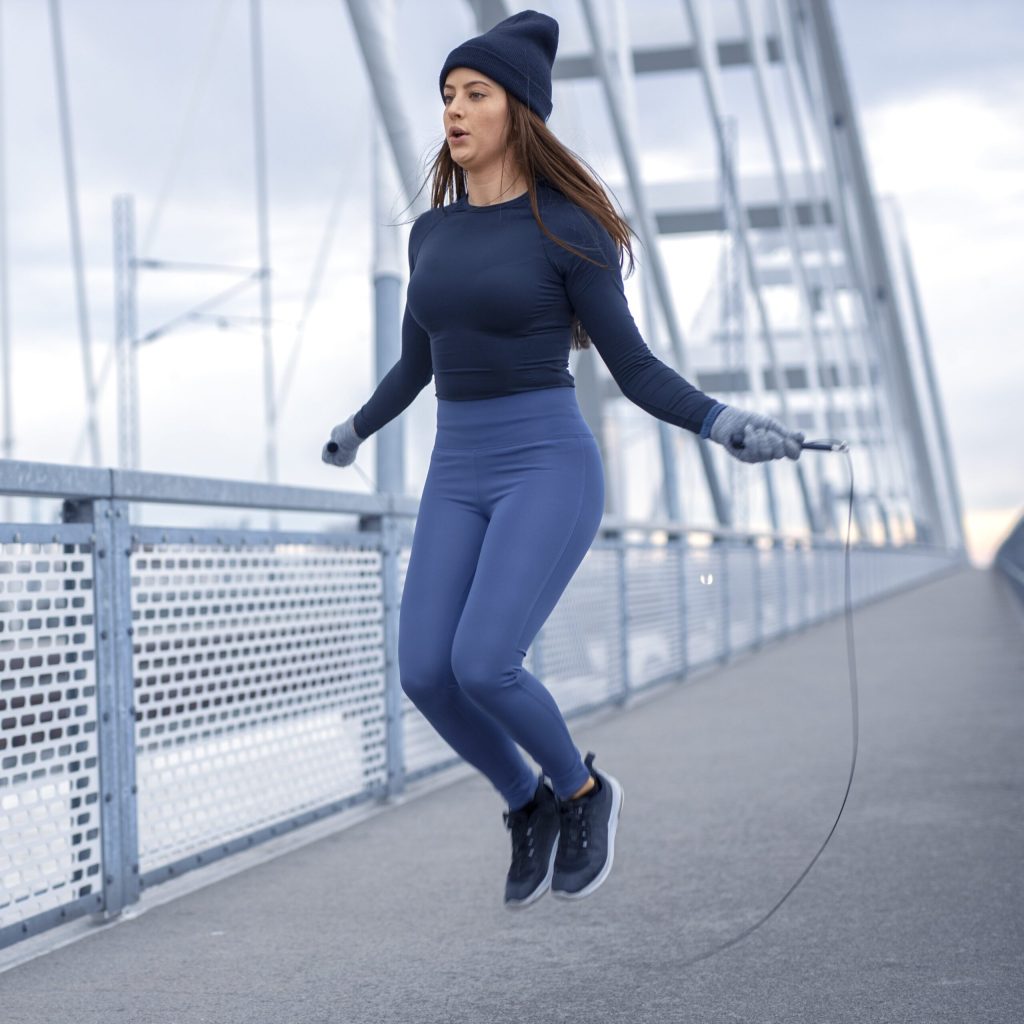Thinking of adding a jump rope into your fitness routine? Jumping rope is a great way to add cardio and break a sweat, even if you only have a few minutes. It’s also easy to do at home or outdoors, and the equipment takes up no space at all.
Jumping rope may conjure up memories of double-dutch on the playground, or even better, the famous DCOM “Jump In!”. But this fun childhood pastime can also make for a killer workout, when you’re armed with the right information. POPSUGAR spoke with Tim Haft, certified personal trainer and founder of Punk Rope, to learn about the benefits of jumping rope and how to get started.
Benefits of Jumping Rope
When it comes to jumping rope, the benefits are plenty – from improved coordination and bone density, to better agility and overall body composition. Here’s what adding a jump rope to your workout plan could do.
Improved coordination
Jumping rope requires the jumper to first turn the rope, and then jump over
it. That sounds simple, but to successfully continue jumping, the two
movements must be well coordinated. To successfully jump
fast, the timing must be flawless; to successfully jump for a long time, the rhythm must be flawless. That’s why the more you practice jump roping, the more your coordination improves. That’s one of the reasons why jump roping is so popular with boxers, who need excellent coordination, timing, and rhythm to be successful in
the ring.
Improved agility
Another area where jump roping shines from a fitness
perspective is helping athletes improve their ability to quickly
change direction and change the position of their feet as well as
their hands, says Haft. This agility training is what makes jump roping popular
with grapplers, tennis players, and basketball players.
Improved proprioception (your own awareness of your body’s movement and position)
Proprioception
is key for engaging in everyday life, playing sports, and most importantly, avoiding
injury, says Haft. To jump rope successfully you must know where your feet are in
relation to the rope, and if the rope is turning at 180 revolutions per
minute or faster there’s no time to waste as far as fine tuning your
foot, hand, and body position.
Improved bone density
According to the CDC nearly 19% of women aged 50 or over have osteoporosis of the femur, neck, or lumbar spine, and many more women and men have osteopenia. Research done at Brigham Young University found
that jumping 10 to 20 times a day with 30 second breaks between jumps
significantly improved hip bone mass density in women ages 25 to
50 after 16 weeks. And perhaps more significantly, there was a
correlation between the amount of exercise performed and the increase
in bone density. Although the study didn’t look at jump roping
specifically, it’s not a stretch to believe that jumping rope will
lead to increased bone density.
Improved body composition
Research says that an adult who weighs 150
pounds will burn roughly 12 calories per minute performing the basic
bounce at a relatively comfortable pace of 125 revolutions per minute.
Jumping at a faster pace, using a weighted rope, or performing a more
challenging step -such as the double under – also has the potential to increase caloric
expenditure. Depending on volume and intensity, jump
roping can play a major role in your cardio routine.
Who Is Jumping Rope Good For?
Haft has personally seen jumping rope benefit a wide range of people, from children as
young as five to adults as old as 85. The benefits listed above apply to just about everyone. For seniors specifically, jump roping can help
improve balance (even if they only spin the rope to the side and don’t
jump over it), bone density, strength, coordination, and
cardiovascular fitness. Haft notes that
those with orthopedic challenges should be cautious and check with a physician before jumping rope.
Any Risks When It Comes to Jumping Rope?
As with starting any new fitness activity, you should know that it’s safe for
you before you begin. If you have orthopedic issues or other health challenges, check with your physician before
jumping. You’ll want to make sure you have a supportive pair of well-fitting sneakers, as well a good flat surface to jump on, preferably
one that has a little give to it, like a wooden basketball court or a
rubberized track, says Haft. And lastly, of course, you’ll need a jump rope! If you don’t already have one, you can shop POPSUGAR’s fitness line, including our Premium Cable Jump Rope ($13).
For beginners, Haft recommends a rope that’s not too light (avoid cable ropes for now) and
can be adjusted to their height. His last recommendation is to start slowly and
progress slowly, in terms of how much you’re jumping each day, to give your body time
to adapt to the stress of the impact from jumping.

